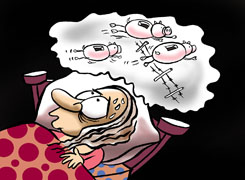44 With 3.8 Crore, How To Plan Retirement & 10.2 Lakh Kids' Education?
Ramalingam Kalirajan |10924 Answers |Ask -Follow
Mutual Funds, Financial Planning Expert - Answered on Oct 03, 2024
He has an MBA in finance from the University of Madras and is a certified financial planner.
He is the director and chief financial planner at Holistic Investment, a Chennai-based firm that offers financial planning and wealth management advice.... more
.jpg)
Age 44, I have 50L in FD, 50 L in PF,30L in stocks, remaining approx 3 cr in real estate.. kids yearly fees is 3.6L now..another 7 years for completing school nd then college 4 years. Monthly expense is 30 k... How can I plan my retirement and kids education?
Now, let’s discuss in detail how you can plan both your retirement and your child’s education, taking into account your goals and the resources available.
Retirement Planning
At age 44, retirement planning should focus on ensuring a secure, comfortable post-retirement life. Your financial goal should be to accumulate enough to sustain your lifestyle and cover medical or unforeseen expenses.
Estimate Your Retirement Corpus
Based on your current expenses of Rs 30,000 per month, calculate how much you will need during retirement. Factor in inflation, say 6-7% per annum. This will help you plan the exact retirement corpus required. This corpus will give you financial freedom in the years to come.
Diversify Your Investment Portfolio
Your portfolio is heavily concentrated in real estate. While this offers security, it lacks liquidity and growth. I suggest reducing exposure to real estate and shifting a part of these funds into more liquid and growth-oriented instruments like equity mutual funds. You could begin by liquidating a portion of your real estate holdings when the time is right.
Allocate a Portion to Equity Mutual Funds
Equity mutual funds can offer higher returns over the long term, which is crucial for wealth creation. Actively managed funds tend to outperform index funds, especially in India’s developing market, by focusing on better stock picking and active management. They can help grow your wealth for retirement.
Fixed Deposits: Limit Your Exposure
Your Rs 50 lakh in fixed deposits is safe but provides limited returns. Since FD returns may barely beat inflation, keep only a small portion in FDs for emergency liquidity. Move the rest to mutual funds that can provide better inflation-beating returns over the long term.
Provident Fund Contributions
Provident Fund (PF) is a solid low-risk instrument with assured returns. Keep contributing to it. It acts as a steady retirement fund that compounds over time. This ensures a reliable income stream when you retire.
Plan for Healthcare Costs
Medical expenses could be a significant burden post-retirement. Ensure you have adequate health insurance in place. You could also keep a portion of your retirement savings in safer debt mutual funds for healthcare or emergency purposes.
Reduce Loans Before Retirement
If you have any loans, plan to pay them off before retirement. Entering retirement debt-free will ensure your corpus can fully serve your living expenses. Avoid taking any new loans as you approach retirement.
Child’s Education Planning
Education costs are rising rapidly. You must plan adequately to meet these expenses without dipping into your retirement savings.
Estimate Future Education Costs
You’ve mentioned that your child’s current school fees are Rs 3.6 lakh per year, with seven years left before they enter college. Education inflation can be quite steep, around 8-10% per year. Factor this into your future cost calculations.
Create a Separate Education Fund
You need to start creating a dedicated education fund. Start a Systematic Investment Plan (SIP) in mutual funds to build this fund over the next seven years. This will allow you to meet school and college expenses without disrupting other financial goals.
Use Equity for Long-Term Goals
Since your child’s college education is more than a decade away, you have a reasonable investment horizon. Invest in equity mutual funds, which can provide high growth over the long term. This will help you accumulate enough wealth for your child’s college fees.
Consider Education Loans
For higher education, don’t hesitate to take an education loan if necessary. Education loans offer favorable interest rates and can ease the financial burden on you. This also helps instill financial responsibility in children.
Reviewing Your Real Estate Holdings
Currently, you have Rs 3 crore invested in real estate. Although real estate provides a sense of security, it lacks liquidity. It’s wise to consider reducing the proportion of real estate in your portfolio to bring balance.
Real Estate as Long-Term Investment
While real estate does offer growth, it should not form a large part of your retirement corpus because of liquidity constraints. A better-balanced portfolio would have real estate, equity, and debt instruments.
Plan Real Estate Liquidation
Consider liquidating a part of your real estate holdings gradually. Use the proceeds to reinvest in equity mutual funds and other instruments that can give you better growth and liquidity.
Estate Planning and Legacy
Ensuring your legacy is protected for your family is essential. Consider creating a detailed estate plan that includes:
Drafting a Will
Have a will in place to specify how your assets should be distributed among your heirs. This will prevent future legal disputes and ensure your wishes are followed.
Nominate Beneficiaries for Financial Assets
For all your financial accounts and investments, ensure that nominees are clearly mentioned. This will make the transfer of assets smoother for your family in your absence.
Create a Trust for Minor Children
If your children are minors, you may consider setting up a trust. This ensures that their education and financial needs are met in your absence.
Tax Planning
Tax planning can help optimize your returns and reduce your tax liability, allowing you to save more for retirement and education.
Use Section 80C for PF, PPF, and ELSS Investments
Maximize your tax-saving opportunities by fully utilizing deductions available under Section 80C. Your provident fund contributions already fall under this section. You can also consider investing in Equity Linked Savings Schemes (ELSS) for additional tax-saving opportunities. ELSS has a lock-in of three years and can provide equity-linked growth.
Long-Term and Short-Term Capital Gains Taxation
Equity mutual funds attract capital gains tax. Long-term capital gains (LTCG) above Rs 1.25 lakh are taxed at 12.5%, while short-term capital gains (STCG) are taxed at 20%. Be mindful of this while planning your redemptions.
Avoid Tax Drain from Fixed Deposits
Interest from fixed deposits is taxed as per your income tax slab, which can lead to a higher tax burden. This is another reason to limit exposure to FDs and move toward more tax-efficient instruments like mutual funds.
Finally
Your current financial situation gives you a strong foundation, and with careful planning, you can secure both your retirement and your child’s education needs. Focus on balancing your portfolio to ensure liquidity, growth, and safety. Revisit your financial plan periodically to make adjustments as needed.
By making informed decisions, you can achieve financial independence and provide for your child’s future.
Best Regards,
K. Ramalingam, MBA, CFP,
Chief Financial Planner,
www.holisticinvestment.in
https://www.youtube.com/@HolisticInvestment
You may like to see similar questions and answers below
Ramalingam Kalirajan |10924 Answers |Ask -Follow
Mutual Funds, Financial Planning Expert - Answered on Jul 19, 2024
Ramalingam Kalirajan |10924 Answers |Ask -Follow
Mutual Funds, Financial Planning Expert - Answered on Jul 10, 2025
Sunil Lala | Answer |Ask -Follow
Financial Planner - Answered on Jul 15, 2025
Ramalingam Kalirajan |10924 Answers |Ask -Follow
Mutual Funds, Financial Planning Expert - Answered on Aug 04, 2025
Mayank Chandel |2580 Answers |Ask -Follow
IIT-JEE, NEET-UG, SAT, CLAT, CA, CS Exam Expert - Answered on Dec 23, 2025
Mayank Chandel |2580 Answers |Ask -Follow
IIT-JEE, NEET-UG, SAT, CLAT, CA, CS Exam Expert - Answered on Dec 23, 2025
Mayank Chandel |2580 Answers |Ask -Follow
IIT-JEE, NEET-UG, SAT, CLAT, CA, CS Exam Expert - Answered on Dec 23, 2025
Mayank Chandel |2580 Answers |Ask -Follow
IIT-JEE, NEET-UG, SAT, CLAT, CA, CS Exam Expert - Answered on Dec 23, 2025
Radheshyam Zanwar |6755 Answers |Ask -Follow
MHT-CET, IIT-JEE, NEET-UG Expert - Answered on Dec 23, 2025
Radheshyam Zanwar |6755 Answers |Ask -Follow
MHT-CET, IIT-JEE, NEET-UG Expert - Answered on Dec 23, 2025
Purshotam Lal |70 Answers |Ask -Follow
Financial Planner, MF and Insurance Expert - Answered on Dec 23, 2025
Purshotam Lal |70 Answers |Ask -Follow
Financial Planner, MF and Insurance Expert - Answered on Dec 23, 2025
Samraat Jadhav |2522 Answers |Ask -Follow
Stock Market Expert - Answered on Dec 23, 2025
Samraat Jadhav |2522 Answers |Ask -Follow
Stock Market Expert - Answered on Dec 23, 2025

























